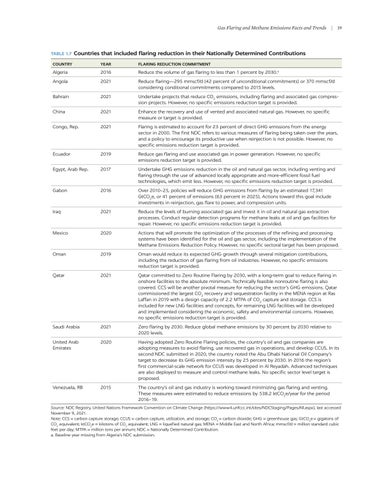Gas Flaring and Methane Emissions Facts and Trends
TABLE 1.7
|
19
Countries that included flaring reduction in their Nationally Determined Contributions
COUNTRY
YEAR
FLARING REDUCTION COMMITMENT
Algeria
2016
Reduce the volume of gas flaring to less than 1 percent by 2030.a
Angola
2021
Reduce flaring—295 mmscf/d (42 percent of unconditional commitments) or 370 mmscf/d considering conditional commitments compared to 2015 levels.
Bahrain
2021
Undertake projects that reduce CO2 emissions, including flaring and associated gas compression projects. However, no specific emissions reduction target is provided.
China
2021
Enhance the recovery and use of vented and associated natural gas. However, no specific measure or target is provided.
Congo, Rep.
2021
Flaring is estimated to account for 23 percent of direct GHG emissions from the energy sector in 2000. The first NDC refers to various measures of flaring being taken over the years, and a policy to encourage its productive use when reinjection is not possible. However, no specific emissions reduction target is provided.
Ecuador
2019
Reduce gas flaring and use associated gas in power generation. However, no specific emissions reduction target is provided.
Egypt, Arab Rep.
2017
Undertake GHG emissions reduction in the oil and natural gas sector, including venting and flaring through the use of advanced locally appropriate and more-efficient fossil fuel technologies, which emit less. However, no specific emissions reduction target is provided.
Gabon
2016
Over 2010–25, policies will reduce GHG emissions from flaring by an estimated 17,341 GtCO2e, or 41 percent of emissions (63 percent in 2025). Actions toward this goal include investments in reinjection, gas flare to power, and compression units.
Iraq
2021
Reduce the levels of burning associated gas and invest it in oil and natural gas extraction processes. Conduct regular detection programs for methane leaks at oil and gas facilities for repair. However, no specific emissions reduction target is provided.
Mexico
2020
Actions that will promote the optimization of the processes of the refining and processing systems have been identified for the oil and gas sector, including the implementation of the Methane Emissions Reduction Policy. However, no specific sectoral target has been proposed.
Oman
2019
Oman would reduce its expected GHG growth through several mitigation contributions, including the reduction of gas flaring from oil industries. However, no specific emissions reduction target is provided.
Qatar
2021
Qatar committed to Zero Routine Flaring by 2030, with a long-term goal to reduce flaring in onshore facilities to the absolute minimum. Technically feasible nonroutine flaring is also covered. CCS will be another pivotal measure for reducing the sector’s GHG emissions. Qatar commissioned the largest CO2 recovery and sequestration facility in the MENA region at Ras Laffan in 2019 with a design capacity of 2.2 MTPA of CO2 capture and storage. CCS is included for new LNG facilities and concepts, for remaining LNG facilities will be developed and implemented considering the economic, safety and environmental concerns. However, no specific emissions reduction target is provided.
Saudi Arabia
2021
Zero flaring by 2030. Reduce global methane emissions by 30 percent by 2030 relative to 2020 levels.
United Arab Emirates
2020
Having adopted Zero Routine Flaring policies, the country’s oil and gas companies are adopting measures to avoid flaring, use recovered gas in operations, and develop CCUS. In its second NDC submitted in 2020, the country noted the Abu Dhabi National Oil Company’s target to decrease its GHG emission intensity by 25 percent by 2030. In 2016 the region’s first commercial-scale network for CCUS was developed in Al Reyadah. Advanced techniques are also deployed to measure and control methane leaks. No specific sector level target is proposed.
Venezuela, RB
2015
The country’s oil and gas industry is working toward minimizing gas flaring and venting. These measures were estimated to reduce emissions by 538.2 ktCO2e/year for the period 2016–19.
Source: NDC Registry, United Nations Framework Convention on Climate Change (https://www4.unfccc.int/sites/NDCStaging/Pages/All.aspx), last accessed November 9, 2021. Note: CCS = carbon capture storage; CCUS = carbon capture, utilization, and storage; CO2 = carbon dioxide; GHG = greenhouse gas; GtCO2e = gigatons of CO2 equivalent; ktCO2e = kilotons of CO2 equivalent; LNG = liquefied natural gas; MENA = Middle East and North Africa; mmscf/d = million standard cubic feet per day; MTPA = million tons per annum; NDC = Nationally Determined Contribution. a. Baseline year missing from Algeria’s NDC submission.


